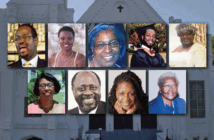Do the challenges of a global pandemic and extreme polarization seem insurmountable? Lewis Center Director F. Douglas Powe Jr. interviews Retired Major General Randy Manner on how clear vision and values help in navigating difficult terrain by engendering unity and hope.
Listen to this interview, watch the interview video on YouTube, or continue reading.
Douglas Powe: You’ve worked in a lot of different arenas. Can you give a little background on yourself and some of the work you’ve done?
Randy Manner: I’ve had a very, very blessed life. My background is military. My dad was in the Army, in Vietnam, a career soldier. My grandfather was in the Navy during World War II. In fact, my son is in the Air Force on active duty right now. And I served 36 years in the US Army.
But my military career was somewhat unusual. I had 10 years of active duty as a regular officer, what you typically think of — an airborne ranger, jumping out of airplanes, going around the world. Then I picked up a Master of Business Administration in decision sciences. I was a technical person, so I decided to get off active duty, and instead I joined the part-time National Guard in Virginia. Over the next 16 years, I worked with a multibillion-dollar international IT consulting company, starting as an analyst and working my way up to chief information officer and general business unit manager responsible for several hundred million dollars of revenue.
Then 9/11 happened. It changed all our lives, including my life and the life of my family. I was recalled to active duty in September 2001. I reported with my unit to the Pentagon to augment the Army Operation Center. We were there within days. The building literally was still smoldering. It was surreal. After a year of active duty, the military asked many of us to continue active duty tours. One year turned into 11 more years. It was a great honor to serve in many capacities around the world to help care for our citizens at home and also safeguard our soldiers, sailors, airmen, marines, the daughters, the sons, the husbands, and the spouses of our great Americans.
I retired from the military in 2012 and went back to school at Georgetown to pick up a postgraduate certificate in leadership coaching. I joined Korn Ferry as a senior partner. Korn Ferry is the largest human capital company in the world, best known for their executive search. I worked on the leadership and talent development side. After several years, I decided I wanted to work fewer hours and for just the clients and customers that I wanted to work for. So, for the past three years, I’ve been working with Fortune 50 Companies, for executives and executive teams, and a lot of pro bono work for both retired and active military, and leaders in other sectors.
Douglas Powe: 9/11 was a time of dramatic change in this country. We are now in another time of dramatic change due to the ongoing pandemic. Based on your experience during these two times of crisis, can you share your thoughts on leading during times of challenging change?
Randy Manner: Change is hard for everyone, especially when we have no control or direct influence over the change. When people start to lose hope or direction, they typically become afraid and fearful. The challenge for leaders is to replace that fear, frustration, and anger with feelings of hope, gratitude and thankfulness, and with action to make something happen. Leaders must step up to provide hope, the feeling that it is going to be better, and then turn that into action. It’s not just preaching. It’s also taking action to back it up.
Douglas Powe: At one time you led the Defense Threat Reduction Agency for the Department of Defense. Can you share what that agency does? And then, in your work there, how did you learn to give hope and navigate some of the challenges?
Randy Manner: The Defense Threat Reduction Agency is probably the quietest organization with the most impact on our country without people ever even knowing it. It’s responsible for helping to ensure that we manage and handle all of our nuclear weapons safely. We had treaties with the Russians where we would go and inspect their nuclear facilities and they would come and inspect ours. It was very, very surreal to be at a Russian nuclear base outside of Moscow, talking to my counterpart, a Russian two-star general, about hopes and fears and so on. And the reality is, they’re just like us. Spending time with people helps us understand that.
The Defense Threat Reduction Agency is also responsible for research and development on prophylactic vaccines. The bad guys can create, without a lot of laboratory assets, things that can do great harm. Something as simple as creating an airborne variety of rabies could be devastating because rabies without treatment has literally an almost 100 percent fatality rate. COVID has a fatality rate of one-third of one percent in the United States. What if we were presented with a problem with a 100 percent death rate? Part of our missions was to identify such potential threats and develop vaccines. These vaccines did not go through the entire FDA approval. As we know from COVID, that can take a year or more by itself and it’s very expensive. The idea is to have things on the shelf in case of an emergency.
During this time, I was also responsible for pandemic planning exercises for the Department of Defense in collaboration with the whole of government, not just federal government. Because of my experience in the National Guard, I also was responsible for coordinating with state and local governments to practice what we would do with different types of diseases that had varying mortality rates. It was an eye-opening experience. And I learned so much that can help make us all safer.
Douglas Powe: As you were thinking about the huge challenge of pandemic preparation, how did you help people stay calm? A pandemic can create a situation where people can panic and things can start to deteriorate. So, what can actually help create the hope you spoke of?
Randy Manner: First, things have changed dramatically over the past four years because the whole concept of dealing with facts has been politicized. Our society used to accept information that was published by a renowned science-based organization or research institute or university that was peer reviewed and backed up with supporting evidence. Regretfully, that’s no longer the case. So, the threshold of truth depends on where you sit and how you feel about the source. Back in 2010 or 2012, it was much, much easier because we would rely on proven research areas.
In today’s environment, it’s very important that church leaders really listen to the concerns of parishioners and then ask, “What are the sources that you might believe in?” and “How can you find out what the truth is?” I know it sounds very simple, but it actually is very important. Having a balanced perspective with multiple sources of information will always yield a better result or answer. Anytime we rely singularly on one person or one source, we can fall victim to propaganda, misinformation, or misguided beliefs. You have to question the sources, and I mean all the sources, to get the best information you can.
So, for leaders, the first task is to give hope. It will get better. I hate to say, “Science shows it.” But the science shows it will get better. The second task is to challenge people to look at multiple sources and make their decisions based on the best available information.
Douglas Powe: In many congregations, people have differing theological and political views. Even looking at multiple sources, they may still end up with different perspectives. So, how can a leader bring people with diverse backgrounds and perspectives together to be united and to be respectful of one another?
Randy Manner: Whether it is in business, the military, a university, or a congregation, a leader must do three things, all falling under the umbrella of creating a vision. The vision has to have three parts. First, what’s the purpose or mission of our congregation? And, by the way, this should only be one sentence. It can’t go on and on. In one sentence, you have to define and agree on the purpose of your congregation.
Second, you have to come up with the half dozen values of your congregation. What’s an example of a value? Using some of the military values I’ll talk about in a few moments, it’s things like integrity, honesty, courage, accountability, duty, loyalty, respect of others, discipline, and teamwork. What are the values your congregation really believes in? After you define in writing the five or six values your congregation stands for, they become a very, very important litmus test for what is acceptable and unacceptable behavior.
Third, what are the key goals of the congregation? What are the three or four things you’re there to do. It could be to serve God in the church. It could be to serve the community in some way, such as a food bank. It could be education.
These three things create the vision. The one-sentence purpose or mission statement, the values that represent the congregation and that everyone agrees to live by, and then the key goals, the three or four constructive actionable things you want to do. It’s the responsibility of the leader to help create the vision and then to communicate that vision and inspire others to actually live and achieve that vision. And by the way, it’s not once. It’s not twice. It’s every week. It’s every day. All the while, you have to be open to tweaking and changing it a little bit as time goes on. This doesn’t mean you come up with a whole new set of values next week. That’s too much change. But adjusting as you to grow into that vision is a very, very, very important part of being open to feedback and change.
The whole concept of being a congregation is coming together for some purposes. You come together because you share a basic belief in God. You come together in a community because you enjoy each other’s company. There are reasons why congregations come together. I’m telling you “just write it down” and then stand behind it. And that can be the hope that you can give your congregation that we can move forward, we can grow together, and we can be inclusive with people who also want to live by our mission, by our values, and by our goals.
Let me share an example from my work. One thing I was asked to do related to guidance put out by the Secretary of Defense was to examine and root out extremism in the military. Speaking freely, I was a little bit perplexed by this approach. The intent was good, but extremism means different things to different people. And quite frankly, people at all points on the political spectrum could be very offended. “Are they coming after me? Are they speaking about me? Because I don’t know where this line is and the training is not clear, either.”
So, I conducted a series of small workshops with well over 100 people, and I basically said, “Whether you are Army or Air Force or whoever you are, the litmus test for you is your service values. The values of respect for others, integrity, truthfulness, honesty, and courage — not just on the battlefield but courage to do what is right and speak the truth.” These values are well defined, and they are taught nonstop when the person first enters basic training in the military. I hypothesized that these values should really be the litmus test of what is extreme. Extremism in a Facebook posting, extremism in a verbal interaction — you apply your service values as the litmus test. The question is no longer “Where’s the line that defines the concept of extremism?” Instead, the question is “What is commensurate with our values and what is not?” Posting something hateful about people of a particular color, race, or national origin is 100 percent unacceptable given the military value of treating others with respect and treating them as you would like to be treated. Whether you call it extremism or not, it doesn’t line up with our values.
The feedback I received was shockingly positive. “Wow! You have given me confidence that I can have a courageous conversation with a friend or a member of my team. I was very nervous before because I didn’t want them to think I was attacking Biden or Trump or their supporters or anyone in between. That’s irrelevant. We’re talking about living and speaking by the values of our service.” And 100 percent of people felt empowered. “Now, I know how to have the most courageous conversations. I can stand up for myself and for my team and the values we have committed to.” So, I would offer that you can do the very same thing in your congregation if you create this vision of the purpose and mission, your most important values, and your key goals; and then you communicate and inspire others.
Douglas Powe: What are some common mistakes that the clients that you coach make in trying to lead change? And how can people avoid those mistakes?
Randy Manner: Well, the number one mistake is not having the vision and not communicating it. Because without that, you are wandering through the wilderness. You’re just going through the same old routine every day. If you are doing the same thing every day, you’re not serving God, you’re not serving your congregation, and you’re not serving yourself. You need to challenge yourself, you need to challenge your team to do more, because life on this planet is too short. You need to do the best you can with whatever your vision is.
People have choices now. Many are quitting their jobs. And they’re not always taking new jobs. Why? Money is not the issue, because you can get employment almost anywhere. It’s finding what you believe in, where you can say, “I can be part of this. I can be inspired by it. I like that leader. I like that product. I like that company. I like the culture. I want to be part of that.”
The same thing goes for our congregations. You can either attract people and keep them or, quite frankly, they’re going to leave or die off and you have an ever-shrinking congregation. So, if you find yourself going through the motions, you need to inject some passion and some energy into what you believe. Because the same old same old does not work. It might feel good. But it doesn’t really work very well. It’s mediocre, at best. We want to make a difference in people’s lives, in their souls, in their hearts, and in their mind. And the way you do it is by having a vision, by using values as the litmus test to bring everyone together because you have far more things in common to be thankful for than the tiny number of things that divide us. And it’s important to remember that.
We really need to embrace that which makes us strong that we all believe in. What doesn’t work is not having a vision, not having agreed-upon values, not having actions that help move the congregation forward to do great things in your community, for your parishioners and for serving God.
 Related Resources
Related Resources
- 5 Ways to Overcome Common Obstacles to Change by Daniel M. Cash and William H. Griffith
- The Promise and Peril of Conflict by Dave Brubaker
- Daring to Think Forward in a Time of Accelerating Change, an in-depth interview with Dwight Frieson
- Discovering God’s Future for Your Church Video Tool Kit







